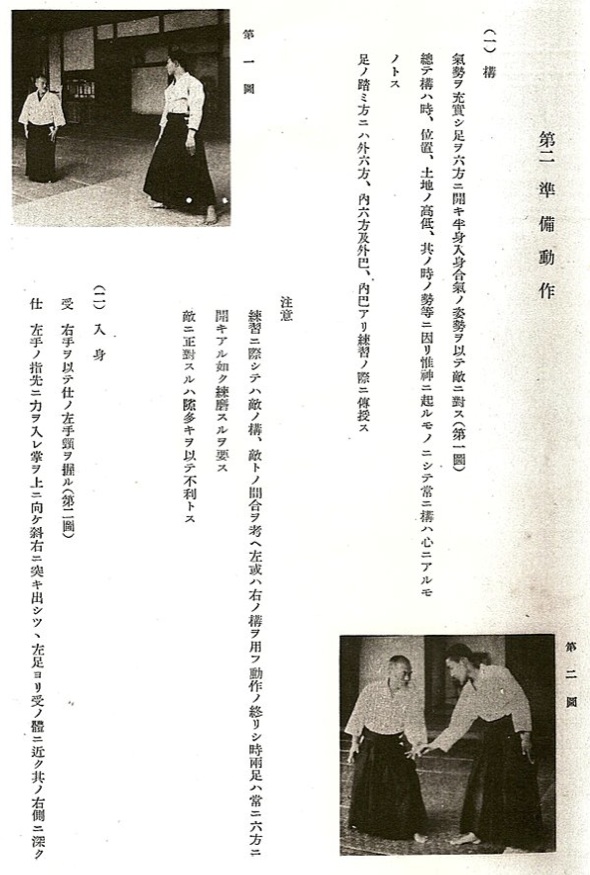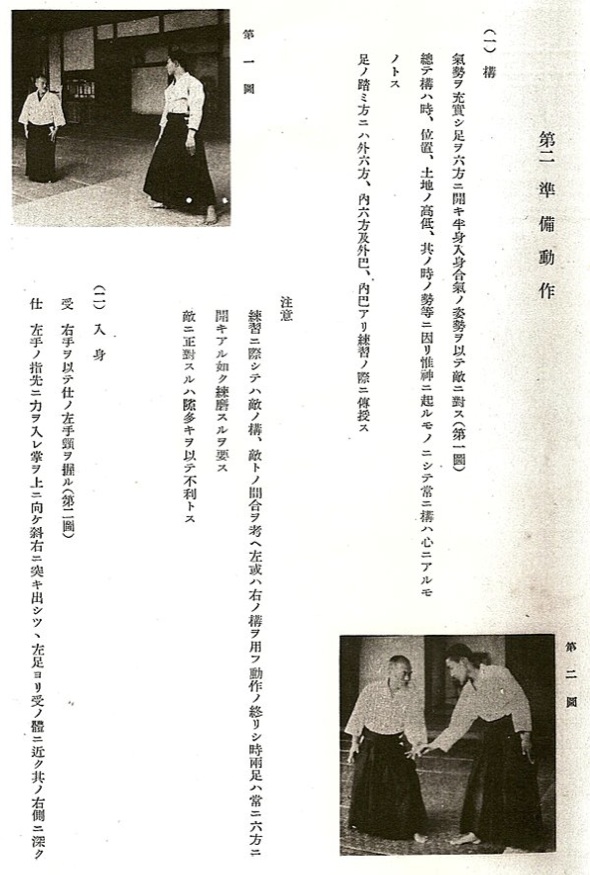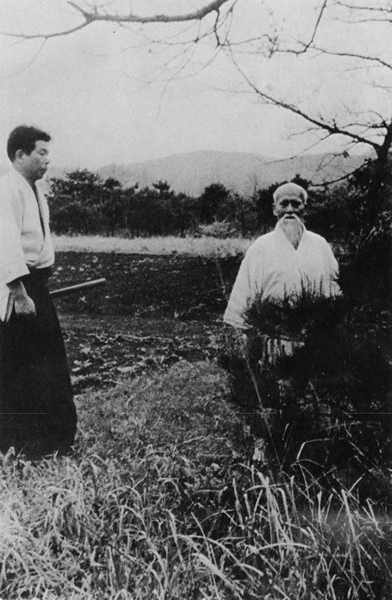 Morihiro Saito and Morihei Ueshiba in Iwama
Morihiro Saito and Morihei Ueshiba in Iwama
“Traditional Aikido – volume 2”
While he was working for the former Japan National Railways, Morihiro Saito Sensei lived in the Iwama Dojo compound, taking care of O Sensei and the Aiki Shrine and teaching in the Iwama Dojo. Sensei was devoted to O Sensei and for this I respect him. I often met Saito Sensei when I accompanied O Sensei to Iwama and during preparations for the Aiki festival. O Sensei was always there, so I don’t have any memories of taking any of Saito Sensei’s classes.
O Sensei was more than 75, so his techniques and movements had fully matured. Kisshomaru Sensei wasn’t around, and the techniques and movements changed. In one direction, Saito Sensei absorbed completely the movements and techniques that O Sensei had taught when he was healthy and strong. Since O Sensei lived in Iwama which had the Aiki Shrine as well, I think in that context it is proper to speak of “preserving the traditional Aikido of Iwama.” The Iwama Dojo was located in a large garden-like compound which was needed to practice ken and jo. O Sensei would teach ken and jo however he felt inclined, and then the next day would do something completely different. It was owing to the genius of Saito Sensei that an easy to understand system of teaching jo and ken was established. My dojo’s Igarashi Sensei cooperated with Saito Sensei’s publication of his book on jo and ken. When I was shown the first edition of the book, I noticed there was no photograph of O Sensei. I said something about this to Saito Sensei and he replied that he had no good photographs of O Sensei. Good photographic equipment wasn’t so readily available in those days. In the second edition appears photographs of O Sensei which I gave to Saito Sensei.
With this kind of connection, Aikido Kobayashi Dojos have incorporated regular ken and jo practice. Saito Sensei highly praised us for this. Today, in overseas seminars, everyone has their own jo and ken; this is Saito Sensei’s legacy.
Yasuo Kobayashi talking about Morihiro Saito in “Aikido, My Way“
Morihiro Saito Sensei was born on March 31st, 1928 and passed away on May 13th, 2002. For more than twenty years during that time he trained directly under Aikido Founder Morihei Ueshiba, one of his closest and longest serving students.
Morihiro Saito acted as the guardian of the Aiki Shrine until his passing in 2002. He is famous for his dedication to preserving the exact form of Morihei Ueshiba’s techniques as he was taught them during his training under him in Iwama.
This is the third section of the English translation of a three part interview that originally appeared in “Answers from Budoka” (“Budoka no Kotae” / 武道家の答え), published by BAB Japan in 2006. You may wish to read Part 1 and Part 2 before reading this section.
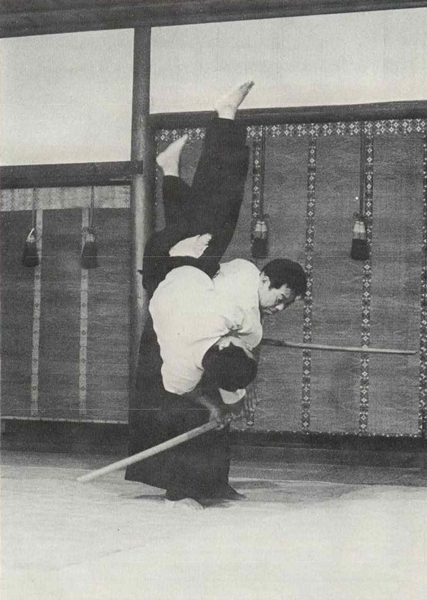 Morihiro Saito – “Traditional Aikido – volume 2”
Morihiro Saito – “Traditional Aikido – volume 2”
Budoka no Kotae – Talking to Morihiro Saito Sensei, Part 3
Q: Was it possible that he had some goal in mind?
A: No, that’s not it. He was angry. Because even though he would tell them to practice precisely and sharply they would only do flowing training. It annoyed them when the Founder said that and scolded them, so they would call and say “Saito-san, tell him that something came up and call him (the Founder) home”. When O-Sensei was there they’d say “That annoying old man is here”. So the Founder’s feelings finally snapped and he stopped teaching there.
Q: Something like “Respect from a safe distance” (敬して遠ざける)?
A: That’s right. For that reason, when he returned here he would stamp his feet and yell. Things like “Unacceptable!” (なっとらん!).
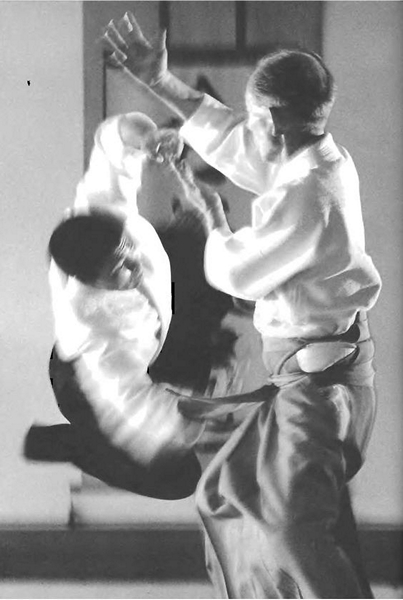 Ni-Dai Doshu Kisshomaru Ueshiba at Aikikai Hombu Dojo
Ni-Dai Doshu Kisshomaru Ueshiba at Aikikai Hombu Dojo
The establishment of Hombu style
Q: How did things get that way?
A: I believe that it was caused by the sudden emergence of Aikido into the world after the end of the war. Because those demonstrations showed it in a really beautiful manner. For that reason people flocked to Aikido, and since they showed those people flowing movement everybody was happy. So because of that people said that Aikido is an enjoyable Budo, it’s beautiful, it’s smooth and attractive.
So Hombu Dojo, for that reason, had a temporary golden age. During that time people who were second or third dan scattered across the world. They said that they wanted to make a name for themselves. That is the Hombu Style that foreigners talk about. I followed another path of static training without doing that, so people around the world call that Iwama Style. They became international terms. A division that came about inside the same Aikido.
“Iwama Style” is first known overseas
Q: Is Iwama Style something special?
A: Some people don’t like it, you know, those from Tokyo. Or even from the country areas. So there are a lot of enemies. Even though when one speaks of Iwama Style one is speaking of the Founder’s style…
Q: Was it the same overseas?
A: However, I was rescued by the discovery of that book by the Founder. That book…that researcher into the history of Aiki from America, he found it in the countryside. That book proved that what I am doing is correct.
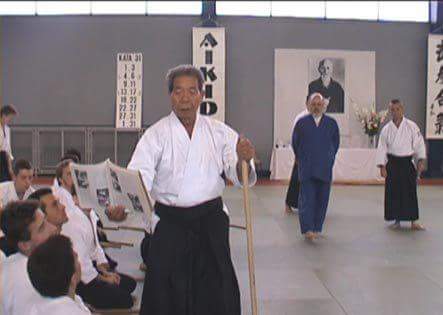 Morihiro Saito teaching from the 1938 technical manual “Budo“
Morihiro Saito teaching from the 1938 technical manual “Budo“
Q: You must have been happy?
A: I was ecstatic! That’s why i carry that copy, and wherever I go I show it to people and say “There you are! Look at this, this is how I am teaching you”. When you compare the training, in the end it slaps them in the face. Aikido began from this Founder, and when you explain this clearly everybody is happy. There was someone from Switzerland who came the other day, tomorrow someone from Canada, they’re throwing away the techniques that they’ve been learning for fifteen years and starting over again from the beginning. I really have to give them credit.
Q: It’s significant that they even had the strength to make that realization, isn’t it? How about the Japanese instructors?
A: As you might expect, one issue is that without financial strength, making the changeover is difficult. Other than that, there are doctors, people running companies, and people who have their own jobs who are realizing that this is different from the Aikido that they have done previously and are devoting themselves to making a changeover. For that reason, I take precisely what I was taught by the Founder, make it easy to understand, and have them study it.
Q: Will you publish a book about that some day?
A: I’m thinking about it.
Q: Who is this? (pointing to the Founder’s book)
A: The Founder used that name at times. He’d use the name Tsunemori (常盛) or Moritaka (守高), but the name that appears in his family register is Morihei (盛平).
Q: Is this the original?
A: No, it’s a copy.
Q: I see, the reproduction is very good. Is there an original copy someplace else?
A: This name here is the name of the person to whom it was given. This was not made public in Tokyo. Perhaps the Ueshiba family has it.
This book is proof that I have been practicing honestly, Ha-ha-ha, it really helped me out. From that time I carry it with me whenever I go out in the world, Because from here this has changed again. I can explain the changes.
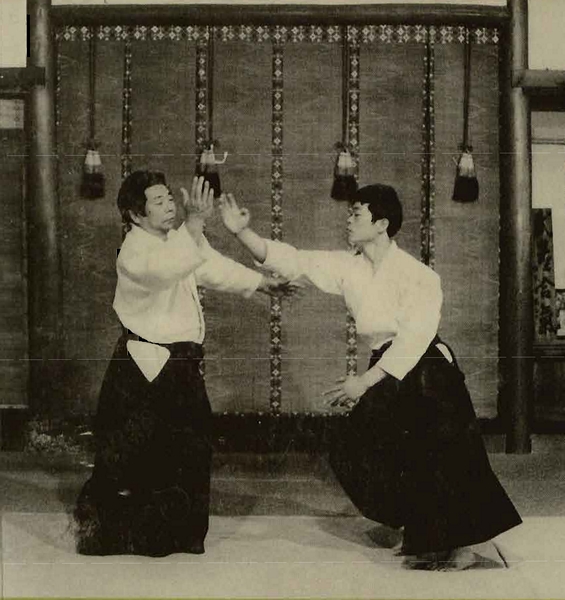 Morihiro Saito – “Traditional Aikido – volume 3”
Morihiro Saito – “Traditional Aikido – volume 3”
Tales of experiences with Aikido (武勇伝)
“Train sincerely in the basics – the power found in them is kokyu-ryoku, Ki is there, Ki is extended, this will be the result.”
Q: By the way, this is a lower level question, but this book is targeted at a general readership who will be happy even with a casual discussion, so may I ask you some of those types of questions?
A: Even now we use these training methods, so in the end I think that I would like people to enjoy what they are reading.
Q: Yes, that’s right, isn’t it? For example, if you will excuse me, if you have some stories of a time that you were caught up in a fight related to Aikido, or a “tale of heroism” (武勇伝), or a story of a spiritual experience, then I would like to ask you about them.
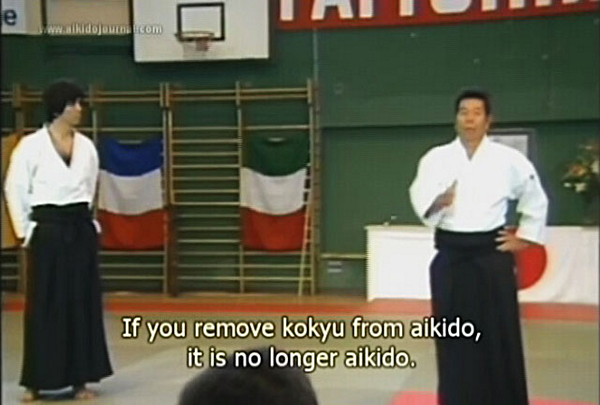 Aikido Journal Editor Stanley Pranin translating for Morihiro Saito
Aikido Journal Editor Stanley Pranin translating for Morihiro Saito
A: I don’t know what you mean by spiritual, but Aikido training has conditioning in breath power (“kokyu-ryoku”), this is an extremely logical method of expressing power.
One night at Chichibu Station there was a fireworks display. About twenty people missed their chance to ride the last train and were in the station’s waiting room.
At that time someone who looked like a yakuza grabbed a young man wearing a business suit by the lapels and started pushing him around. So I said “Hey you, stop that!”, but he wouldn’t stop! Then when I grabbed the arm of the person who looked like a yakuza he let go of the other person and started grappling with me. So I took a step back, put my hand slightly under his chin and went to throw him. When I swept him with my right leg he flew straight backwards and hit his head on the concrete – he lost consciousness. The railway police came right away, so I passed him over to them.
That kind of kokyu-ryoku is what people talk about when they say things like “extend Ki”, but in the end Ki isn’t something special. Train sincerely in the basics – the power found in them is kokyu-ryoku, Ki is there, Ki is extended, this will be the result. When entering through theory without doing the actual techniques one cannot really realize this.
Q: If that is done, when a person surpasses a certain level will they be able to flip an opponent’s body over lightly just by touching them?
A: That’s if one is following the principles strictly, and if the situation at the time allows for it.
People who can match that skillfully with whatever technique is being used are skillful at Aikido. The person who takes the angle rationally is a strong person.
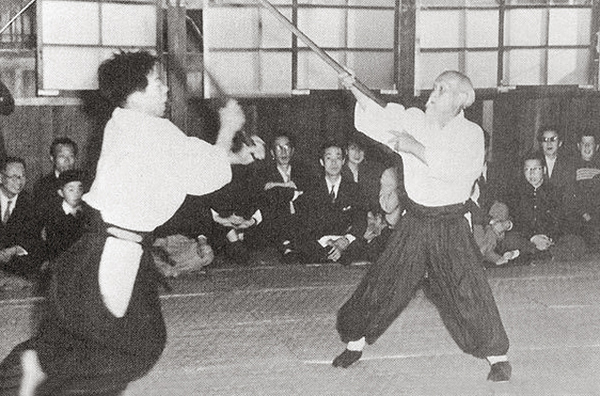 Morihiro Saito and Morihei Ueshiba – 1954
Morihiro Saito and Morihei Ueshiba – 1954
Q: When the opponent is an older person, or someone who’s body is stiff, no matter how skillful one is their way of falling will be unnatural – don’t they ever get injured?
A: There are often people who take pride in injuring others during Aikido training, but if one does it carefully they can become skillful without causing injury. The Founder almost never injured anybody! He taught us like beginners until our ukemi gradually became skillful and then skillfully led us into the bigger throws. When people like children fell he would put his hand under their head as he threw – it was really tender behavior.
As to other stories… Aikido begins with hanmi. If one steps forward, if one steps backward, if one opens or moves forward. I had in experience related to this.
At one time I was employed by the Japan National Railway. The tracks have inbound lines, center lines and outbound lines. On that day, I went out for a task at an engine that had stopped on the center line. At that time the steam engine was puffing steam, and since it was the middle of winter I couldn’t see anything at all. I was standing just at the point of the inbound line. Then, and I don’t really understand this myself, I suddenly jumped out of the way and landed in left-hanmi. You see, I had moved my body out of the way of the train. In that instant, an express train from Aomori passed by on the inbound line.
Q: Wow!
A: The crewmen knew that I was out there, so they thought that I had already been run over. But I was just standing there calmly, so both the crewmen and the people standing on the platform were astonished. I still don’t understand how or why I jumped out of the way or how I sensed that the train was coming. Once the express train passed my knees started knocking. How many years ago was that…it was in my twenties. There are times when human being’s knees actually knock, aren’t there? I was the one who was most surprised.
Q: That was a at a time when you had not yet mastered Aikido, right?
A: But that jumping tai-sabaki matches Aikido methods. I really don’t understand. What did I sense, it was just a short instant of time – conversely, if I had sensed that something was coming I think that might have become unable to move! It must be because I didn’t understand what was happening that I was able to move out of the way.
Q: Did you gain a deeper understanding of the principles of Aikido from that time?
A: Well, it’s something that could have happened to anybody…
Q: Or it may be that it was one of those spiritual experiences that we spoke about previously, don’t you think?
A: I think so. If I had put that tai-sabaki into practice after I became skillful then it wouldn’t have been anything. There was one time that I happened to get caught up in an odd situation.
Q: When was that?
A: Well, about thirty years ago, I think. One day I was drinking with a friend, and we were walking down the street bar hopping when there was a fellow making noise about how his motorcycle wouldn’t start. So, we thought we’d take a look at it, but when we touched the motorcycle all of a sudden we were surrounded. They were from some Kumi (Note: a yakuza group) from some construction site in Asakusa, it seemed that they had been in a fight with some local young people, beat them up and were chasing after them. The motorcycle belonged to their group, and they thought that I had come to get even with them. Hey! Hey! They came at us. Well, we had to protect ourselves (Note: “You have to sweep off the falling sparks” – in other words, protect yourself from possible dangers).
Q: How many of them were there?
A: Coming directly at us there were two people, but we were pretty drunk. I don’t remember a thing, but it seems that I threw them quite a distance while hardly touching them at all. When you are throwing, there are ways to throw so that they can take ukemi, or so that they can’t take ukemi. Because the others were just regular people who had started a fight….
With regards to sempai who force a throw even in training, it would be rude not to take ukemi so one forces themselves to take the ukemi, and then they get injured. I think that those people who injure others have no room in their hearts. Those people who have room in their hearts have feelings of consideration in the midst of their severity and will not cause injuries. People who cause injuries are practicing in an overbearing manner, and in that manner there is a contradiction with the principles, so I think that I would like them to study that area more. I’m not very good at speaking, so I can’t express it well…
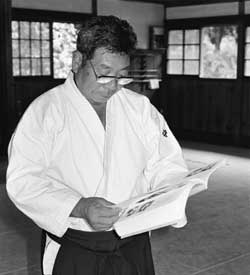 Morihiro Saito reading “Budo“
Morihiro Saito reading “Budo“
The basic training of Aikido is static training
Q: Well, this has been really interesting. By the way, when I watch skillful people training together in Aikido they get thrown quite a distance. Or is it that they are purposefully trying to show something?
A: Do you see training like that? Well, people who train while taking that big ukemi are all weak.
When training in the real basics we don’t allow them to take big ukemi. I throw without allowing them to take big ukemi and then after they fall we hold them down. Some throw partway through. Then the person throwing is already done with their task, and the person being thrown is released there. But in the basics one holds them down until the very end, one does not release their Ki until the very end. It’s there that there is a difference in the degree of conditioning. Here (the Founder’s book, mentioned previously) it is too, in this technique everybody takes the big ukemi but even in this throw he is holding them down. This is basic in Aikido.
Q: Thank you for such a valuable discussion. I hope that many Budo shugyosha will find it a helpful reference.
Published by: Christopher Li – Honolulu, HI

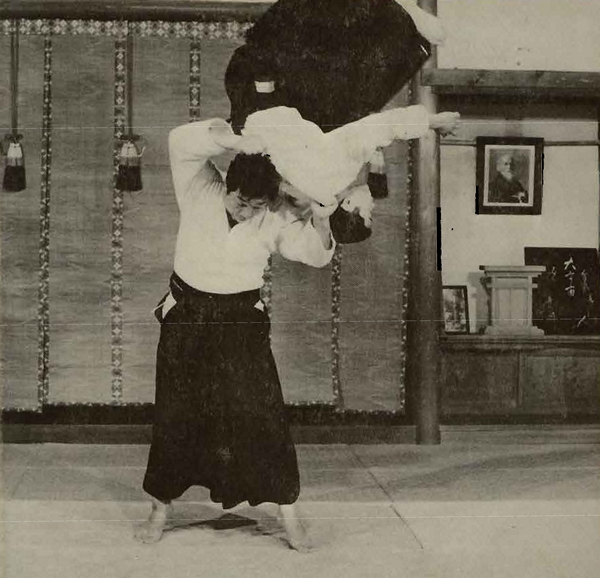
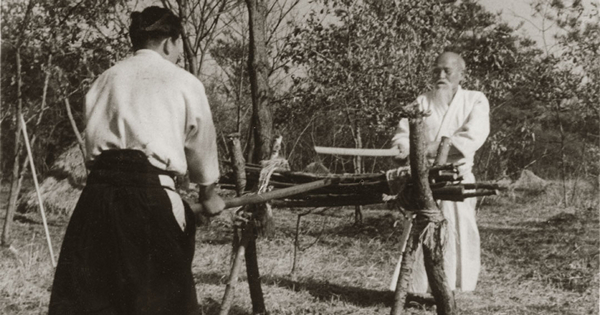 Morihiro Saito and Morihei Ueshiba
Morihiro Saito and Morihei Ueshiba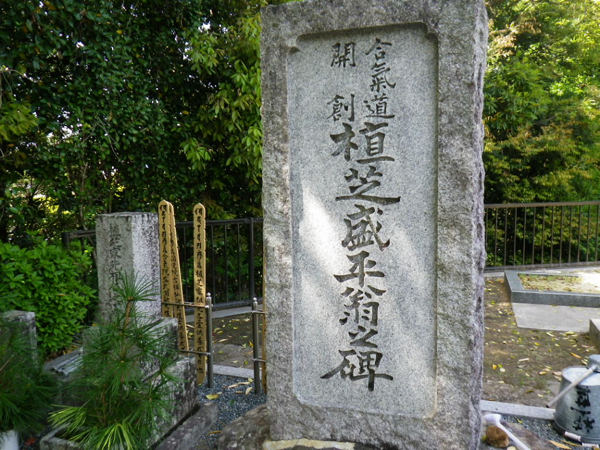 Aikido Founder Morihei Ueshiba’s grave in Kozanji
Aikido Founder Morihei Ueshiba’s grave in Kozanji 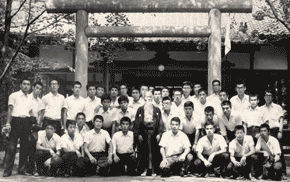 Aikido Founder Morihei Ueshiba with students from Meiji University in Iwama
Aikido Founder Morihei Ueshiba with students from Meiji University in Iwama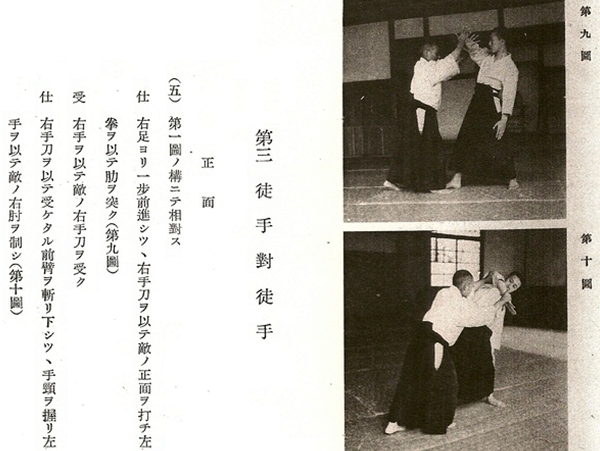 Morihei Ueshiba initiates with an attack
Morihei Ueshiba initiates with an attack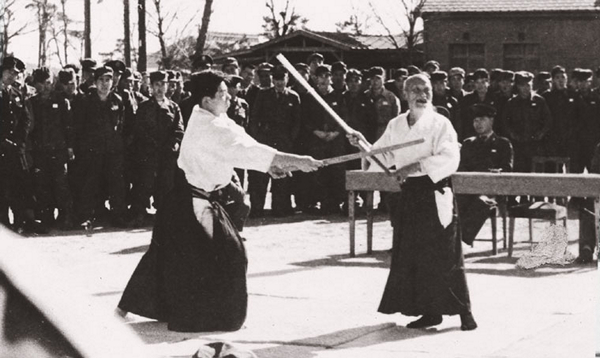 Demonstration for the Jieitai (“Self Defense Forces)
Demonstration for the Jieitai (“Self Defense Forces)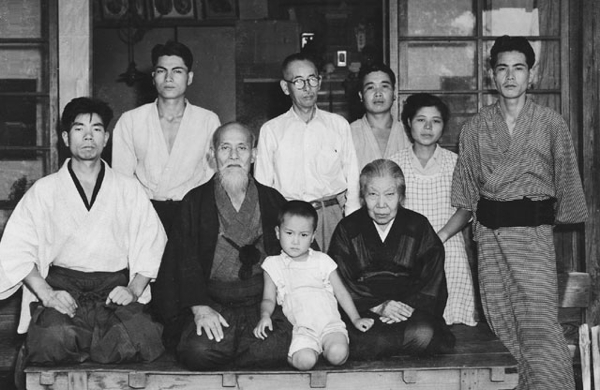
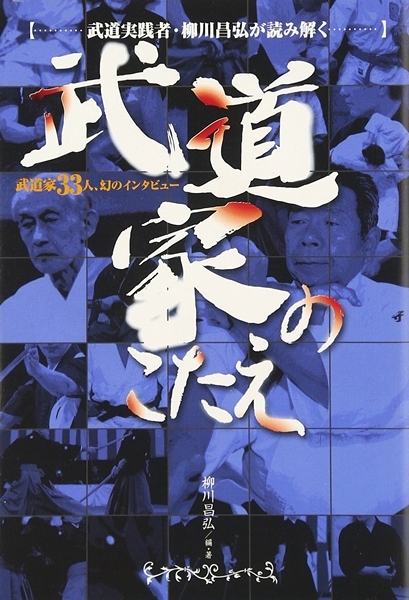 Budoka no Kotae – BAB Japan, 2006
Budoka no Kotae – BAB Japan, 2006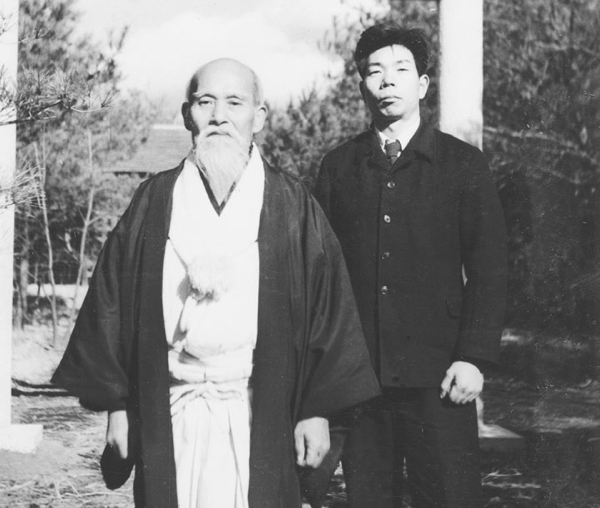 Morihiro Saito with Aikido Founder Morihei Ueshiba
Morihiro Saito with Aikido Founder Morihei Ueshiba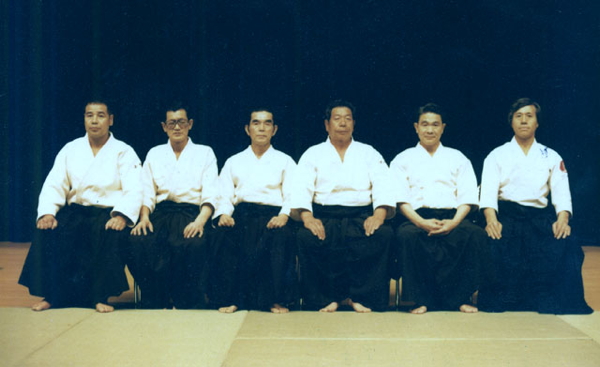 Aikido Instructors at the 1st Aikido Friendship Demonstration in 1985
Aikido Instructors at the 1st Aikido Friendship Demonstration in 1985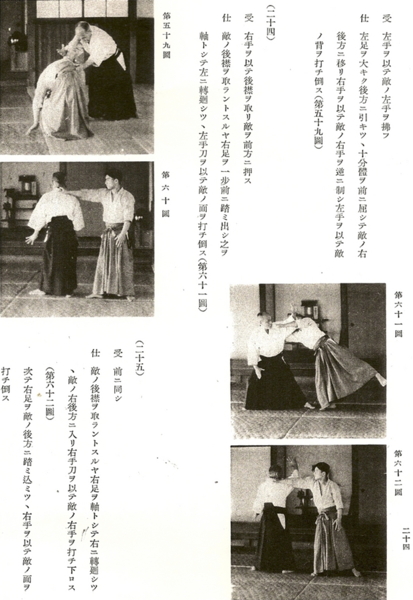 Yoshinkan Aikido Founder Gozo Shioda in “Budo”, 1938
Yoshinkan Aikido Founder Gozo Shioda in “Budo”, 1938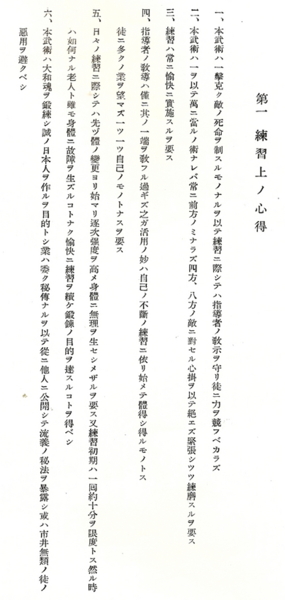 Morihei Ueshiba’s “Rules for Training”
Morihei Ueshiba’s “Rules for Training”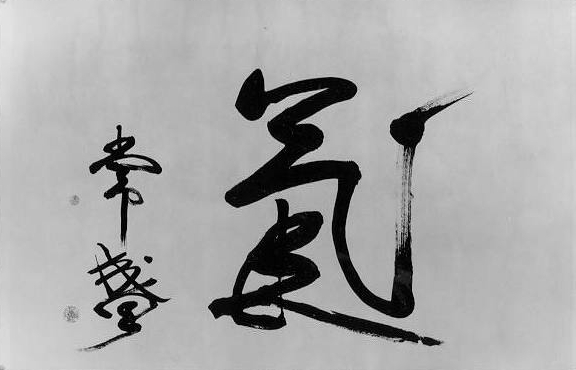
![Morihei Ueshiba, Budo en Kamae [Dutch Version]](https://www.aikidosangenkai.org/blog/wp-content/media/kamae-budo-1938.jpg)
